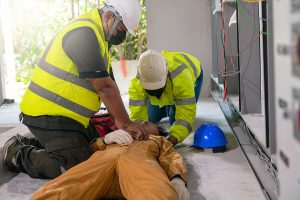Rarely does there exist a more stressful event than the sudden onset of chest pain (or pressure) with accompanying arm or neck pain, dizziness, nausea and/or shortness of breath. All of these symptoms suggest the terrifying possibility of a myocardial infarction – or “heart attack”.
Fortunately, there are protocols in place to attend to those who face an unexpected chest pain and associated symptoms. These protocols are found in the Advanced Cardiac Life Support (ACLS) training given to pre-hospital and hospital health care providers. Not all hospital workers receive this training but those that do (physicians and nurses) are prepared to assist and intervene with appropriate treatment for the possible “MI”.
Remember, “time is muscle” which means the first step is always to place that 9-1-1 call for assistance. So what can the patient expect after the call for help related to complaints of chest discomfort or pain? This is a great question and easily answered based on the ACLS protocols.
Paramedics respond and asses the patient’s status. Upon determining the patient’s presentation fits the potential for cardiac injury, he would be taken to the hospital. En route, baby aspirin (assuming no allergy to aspirin exists), oxygen and possibly sublingual nitroglycerin (a tiny pill placed under the tongue) would be given. An IV would be placed and an EKG possibly completed en route. After arriving in the Emergency Department, the hospital staff takes over and other medications could be given (including additional nitroglycerin and possibly blood thinners), along with another EKG, blood samples and a chest X-ray. The physician would make the determination as to the patient’s condition and supportive staff prepared to do what comes next in the protocol.
Constant communication and efficient interventions are conducted rapidly to save the heart muscle from additional damage. Fortunately, paramedics and hospital personnel are experienced and have amassed the skills necessary to intervene and save a heart from serious injury, even death. What a wonderful resource ACLS is to those who must utilize the protocols to save another’s life – and what a blessing to those who receive the benefits of ACLS protocols utilized on their behalf. A hearty “thank you” is never too much to give back to those who practice ACLS on behalf of their patients.










